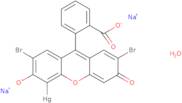Mercurochrome
CAS: 129-16-8
Ref. 3D-FM01528
| 1g | Ausgelaufen | ||
| 25g | Ausgelaufen | ||
| 100mg | Ausgelaufen | ||
| 250mg | Ausgelaufen | ||
| 500mg | Ausgelaufen |
Produktinformation
- Merbromin
- 2,7-Dibromo-4-hydroxymercurifluoresceine disodium salt
- Asceptichrome
- Aseptichrome
- Brocasept
- Chromargyre
- Cinfacromin
- Curichrome
- Curocromo
- Cynochrome
- Mehr Synonyme anzeigen
- Disodium 2,7-dibromo-4-(hydroxymercuri)fluorescein
- Disodium 2′,7′-dibromo-4′-(hydroxymercury)fluorescein
- Emcerol
- Flavurol
- Fluorescein, 2′,7′-dibromo-4′-(hydroxymercuri)-, disodium salt
- Fluorochrome
- Gallochrome
- Gynochrome
- Lafircrom
- Lapicromo
- Mercromina film
- Mercuranine
- Mercuresceine
- Mercurichrome
- Mercurochrome 220 Soluble
- Mercurochrome Practical Grade
- Mercurocol
- Mercurome
- Mercurophage
- Mercury dibromofluorescein disodium salt
- Mercury, (2′,7′-dibromo-3′,6′-dihydroxy-3-oxospiro[isobenzofuran-1(3H),9′-[9H]xanthen]-4′-yl)hydroxy-, disodium salt
- Mercury, (2′,7′-dibromo-3′,6′-dihydroxy-3-oxospiro[isobenzofuran-1(3H),9′-[9H]xanthen]-4′-yl)hydroxy-, sodium salt (1:2)
- Mercury, [2,7-dibromo-9-(o-carboxyphenyl)-6-hydroxy-3-oxo-3H-xanthen-4-yl]hydroxy-, disodium salt
- No. 220 Soluble
- No. 220 sol
- Planochrome
- Sodium 2,7-dibromo-4-hydroxymercurifluorescein
- Sodium mercurescein
- Spiro[isobenzofuran-1(3H),9′-[9H]xanthen]-3-one, 2′,7′-dibromo-3′,6′-dihydroxy-, mercury complex
- Spiro[isobenzofuran-1(3H),9′-[9H]xanthene], mercury deriv.
- Supercromer orto
- disodium [2,7-dibromo-9-(2-carboxylatophenyl)-6-oxido-3-oxo-3H-xanthen-5-yl](hydroxy)mercury
- disodium [2,7-dibromo-9-(2-carboxylatophenyl)-6-oxido-3-oxo-3H-xanthen-5-yl]mercury hydrate
Mercurochrome is a chemical with the chemical formula HgCl. It is used as an antiseptic and disinfectant, due to its ability to kill bacteria. Mercurochrome has been shown to have antimicrobial properties in vitro against a broad range of organisms, including Gram-positive and Gram-negative bacteria, yeast, and fungi. In addition, it has been shown to have inhibitory properties on lymphocyte transformation and polymerase chain reaction (PCR). The mechanism of action for mercurochrome is not fully understood but may be related to the inhibition of protein synthesis and DNA replication by binding to enzymes such as dna gyrase or topoisomerase IV. Mercurochrome has also been shown to affect the body's metabolic processes through interactions with energy metabolism and insulin secretion.





